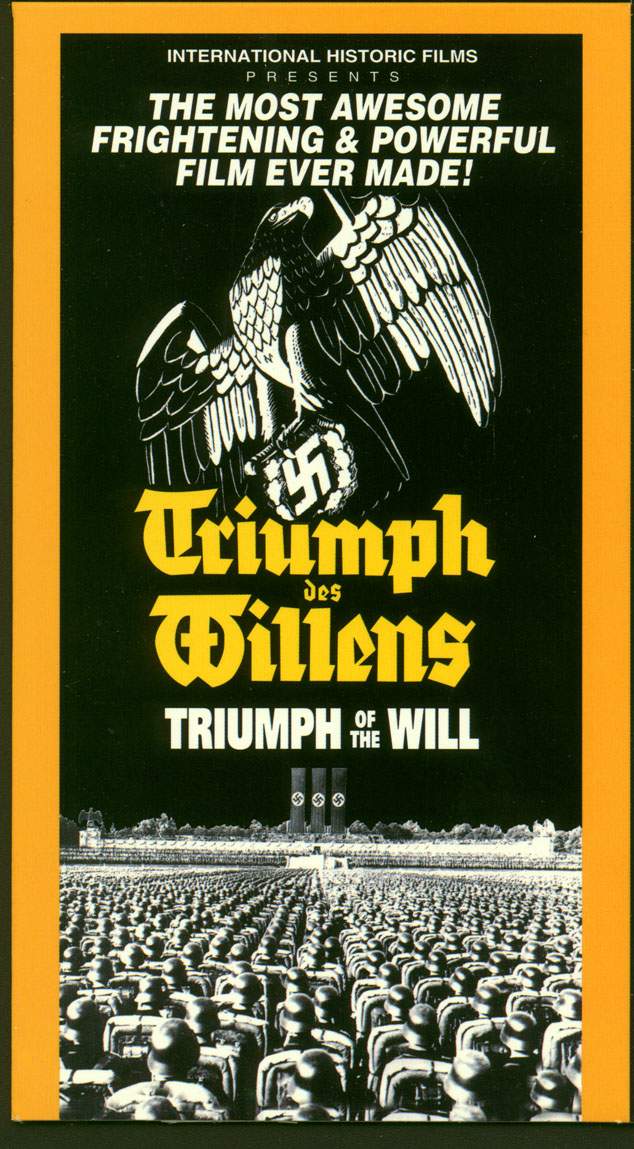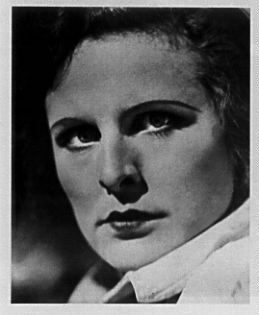
Triumph of the Will (Triumph Des Willens), 1935

Triumph of the Will, 1935
Triumph of the Will is one of Leni Riefenstahl's masterpieces and together with another of her great work, Olympiade (Olympia, 1938), are perhaps two of the best known documentaries ever made. This film is about the 1935 Nazi Party rally in Nuremberg.1 Similar to other commissioned films made by Riefenstahl, the film celebrated the rebirth of body and community, mediated through the worship of an irresistible leader. "It used overpopulated wide shots of masses alternating with close ups that isolate a single passion, a single perfect submission: in a temperate zone clear-cut people in uniforms group and regroup, as if they were seeking the perfect choreography to express their fealty."2 The film shows the Party's principle of order with great vigor. It shows how an individual is absorbed as an element of the greater whole in which the individual "is freed and absorbed into the community of the faithful."3 The film is able to use movement to transform Nazi ideology into [symmetrical] forms that are in turn endowed with dynamic movement.4
 A close up of Leni Riefenstahl. |
Leni Riefenstahl used the rally of masses to show the aesthetic of Nazi movement, whereby individual was fully integrated and absorbed into a mighty collective. It gave the participants, the moviegoers, a sense of power of being one of the collectives. This aesthetic portrayed the collective in new and rigorous art forms, channeling it into a movement that aimed at achieving a glorious future.5 It seems to strengthen the idea that only the individual who joined the Nazi movement was really capable of realizing himself as a part of the whole community. In the film, this community of faith was degraded to the position of cadre that was pure and simple, which was able to move along under the artistic direction of the director.6 The director used the blocks of human masses and banner carrying columns in an aesthetic manner as geometric patterns to create emotional spaces that included the viewers. The masses were molded into compact units of movement to "symbolize the physiological marching in step that evolves, aesthetically transfigured, into harmony between the F�hrer and people."7 Leni Riefenstahl was able to popularize the negative aesthetic of the states (the public was not interested to see party political films as an aesthetic experience) by means of a positive film aesthetic. She was able to transform the boring rituals of the rally with all its speeches and parade into a "hedonistic feast, into an easily sellable art product."8
In the film, top Nazi leaders also mentioned about the ideal of "das Volk" in their speeches. The meaning of Volk refers to the idea of the community or people of the Germany. It is an inner quality or power residing in the German people. Watch the Speeches:
Clearly, the film does portray this idea of the Volk as indicated in the analysis above about how the masses are depicted as powerful collective and as community of faith. It seeks to integrate the individuals into this mighty community. The film also shows the German youths and from the first clip, the great hope placed on these youth by Hitler is shown, as they would represent that Volk. Furthermore, the children as seen in the film fit accordingly to the qualities of the ideal Aryan race such as blond-hair and blue-eyes. Hence, the film seems to propagate the idea that combines the German Volk with the mythological Aryan race.
The swastika flag appears almost in everywhere in her films including Triumph of the Will and has become her leitmotif.9 The swastika flag is an important element in the films to transmit Nazi ideology. It presents the omnipresent of the great leader. It symbolizes the Party's programmes and has become the epitome of Nazi ideology. The symbol of the Black swastika, according to Hitler, was the mission of the struggle for victory for the Aryan man; it had stood for anti-Semitism. It also stood for the rebirth of a new German nation. Throughout the film, the flag was used to communicate all the themes and ideals of Nazi ideology such as the F�hrer, the national community (volksgemeinschaft), the fatherland; obedience, race, faith and hope.10 Leni Riefenstahl was able to use the flags "as an emotional and sentimental prop with which to orchestrate a dizzying symphony of flags which disseminate the Nazi world-view in staged aesthetic events…."11 This could be seen from Triumph of the Will, as flags were shown blowing in wind, as sign of movement and the "forests of flags" seem to symbolize a psychological field of force. 12